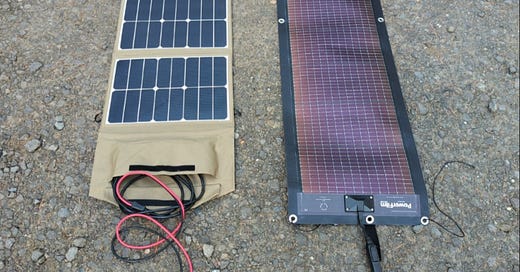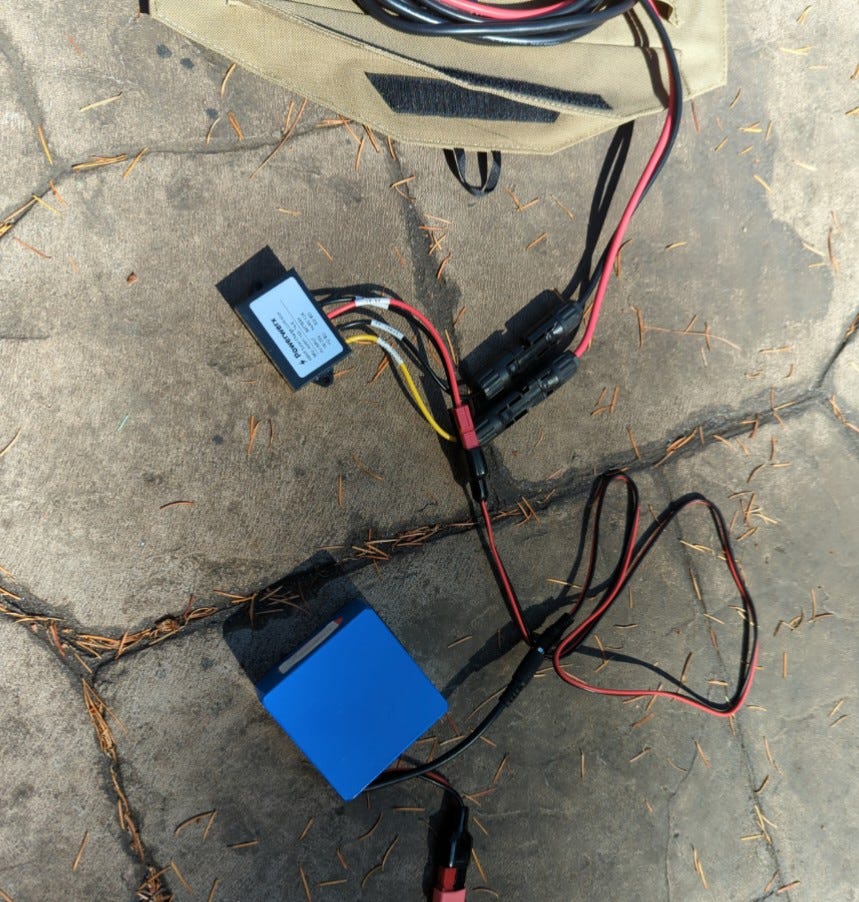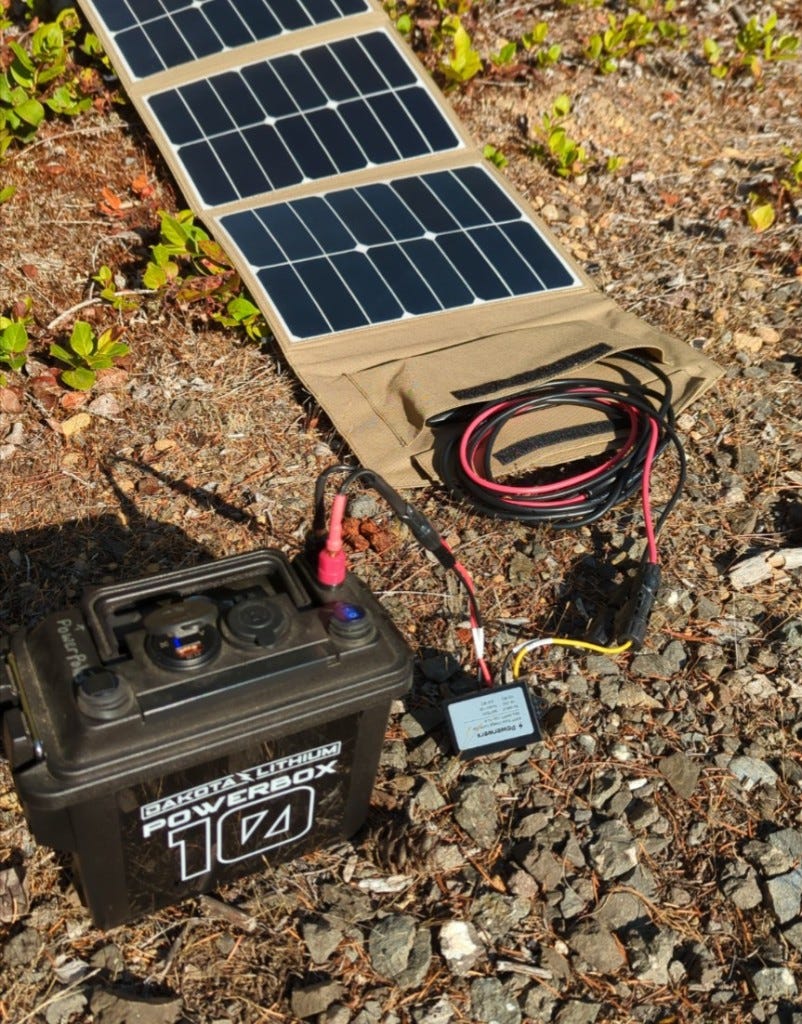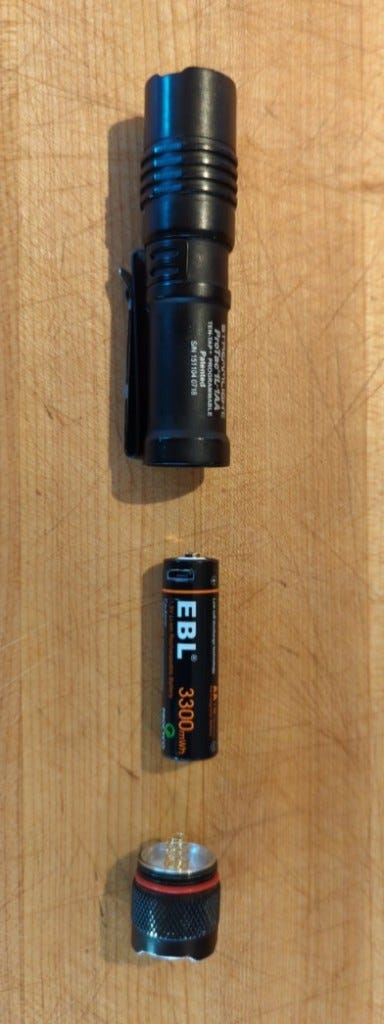Solar for Field Ops
"Mission dictates equipment" so the saying goes, and this might not be truer with anything than solar. I do not carry solar as a rule when operating portable for a couple hours or for AmRRON Field Deployment Saturdays (AFDS), though I certainly do take advantage of opportunities to test equipment. I did bring solar on a trip this summer, and powered a laptop, cell phone, and radio for an entire week. I checked in to every AmRRON net I could receive, Orca net, Western Digital net, as well as operating recreationally when we weren't eating wild game or swimming in the lake, and the 21 watt Powerfilm panel tossed onto the cabin roof kept a 10 AH battery charged with no issues. The Powerfilm is great, IP67 (it works underwater!), efficient even during overcast condx, and at 21 watts does not require a charge controller, just plug it straight into your LiFePo4 battery. But, static ops are where the low watt solar panel will shine. Plenty of time to gather the suns rays and keep the battery topped off "low & slow". What about more mobile ops where you might need to make the most of an hour or so halt to charge a small battery while conserving weight? Well, that's where a higher wattage panel will shine, and the reason for recently acquiring an "Explorer" 60 watt folding panel.
Powerfilm 21 watt (right) and Explorer 60 watt (left) side by side.
It's hard to believe that the panel on the left provides 3 times the power as the one on the right, but like to many other things in life there are no absolutes, only tradeoffs. The powerfilm will perform more efficiently than just about anything under cloudy skies, and that is the quality you get for the higher price you pay. The Explorer will experience a more significant drop in current when the sun is not strong, though it will still work and that reduced performance may still mean more amps into your battery system than a lower power panel.
One of the hurdles to using a higher power solar panel is that you will need to use a charge controller, which adds weight and bulk as well as an additional potential failure point into the system.
Many of the charge controllers on the market are not specifically designed for lower power portable ops, and are therefore built to take much more current than I need, and that capability comes with a lot more bulk than we can accept for this application. This led me to the Powerwerx MPPT-150-14.6. Built for LifePO4 batteries, waterproof, and only 1/4 lb in weight, it can handle up to 150 watts.
One of the reviews however gave me cause for concern as it reportedly "produces S7+ noise across several HF bands". This obviously would be unacceptable for our application but since there are so many variables that cannot be determined from one users experience, and a price point of about $30, I had to give it a try. So upon receipt I set out to test it with the same gear I would carry into the field. I plugged a 3 AH bioenno battery into the Lab599, powered it on with a coax jumper and dummy load, and noted a noise floor of effectively zero. Next I attached the charge controller to the Explorer 60 watt folding solar panel (folded up, so no charging yet), attached the battery to the controller, and there was no change in the noise floor. Finally I unfolded the panel into full sun, watched and waited for 15 minutes and yet the noise floor was unchanged. The battery was partially depleted, so was accepting charge from the panel during test, and afterward I used a multimeter to verify that there was current coming through the charge controller.
Batteries are heavy, and one of the primary advantages of solar is that you can replenish the battery instead of carrying larger / additional ones. For temporary ops I tend to bring a smaller 3AH Bioenno battery along with cables to charge it with a solar panel, as well as recharge the phone / tablet being used for digital modes periodically. This tends to work well, and with reasonable expectations for transmit and monitor time per day could work indefinitely. Once we add a laptop (and the inverter we will have to use to recharge) we need to plan for larger storage capacity.
For long term ops, with the need to recharge a variety of peripheral items while still maintaining low weight, I opt for a slightly modified 10 AH Powerbox from Dakota Lithium. I say slightly modified because I rewired it to remove the 2 LED lamps that I don't want and re-purpose that switch to feed a dual powerpole panel mount. This solves my only real gripe about the Powerbox (no power poles) and now I have USB A, USB C, 12 V car plug (which runs the inverter when required), as well as 2 power pole connections.
The Powerbox has just enough room above the battery but below the wiring to store a few handy cables, so that you can keep peripheral batteries (flashlights, NVG, IR Lasers ETC) charged up indefinately.
So there we have it, just remember not to copy someone else's kit but instead make decisions on what works for you given your requirements. Now get out there are test yourself and your gear and remember, shit happens so plan for success not perfection!







